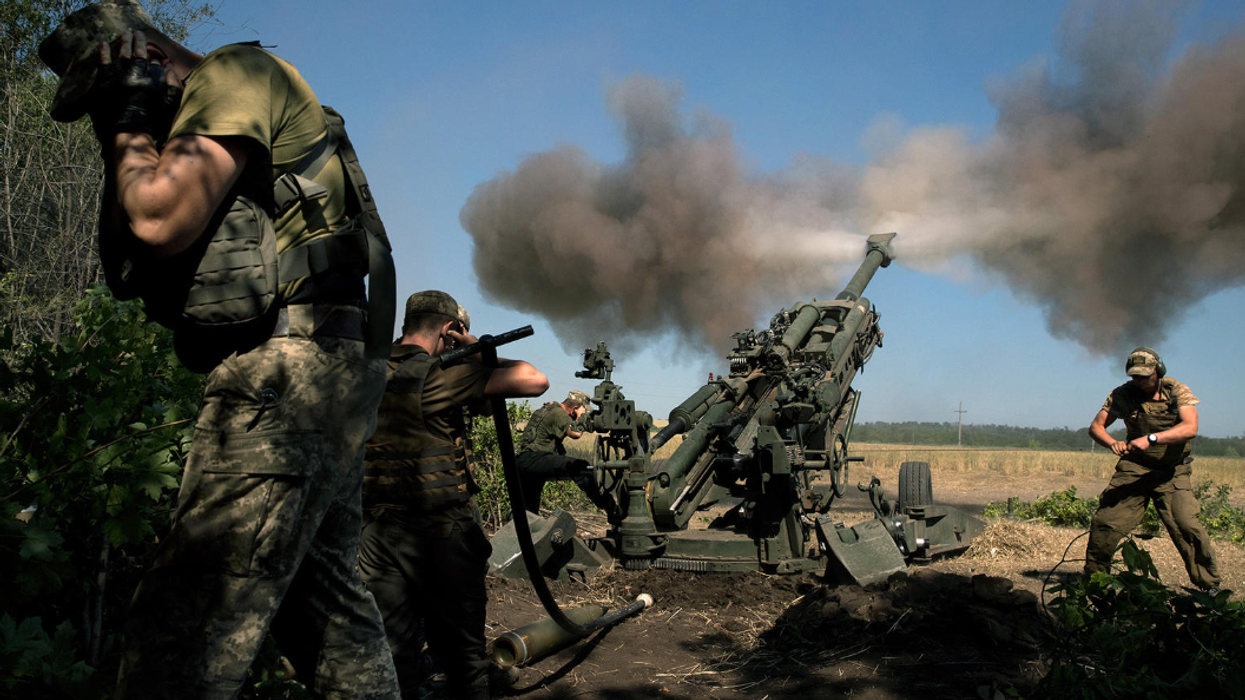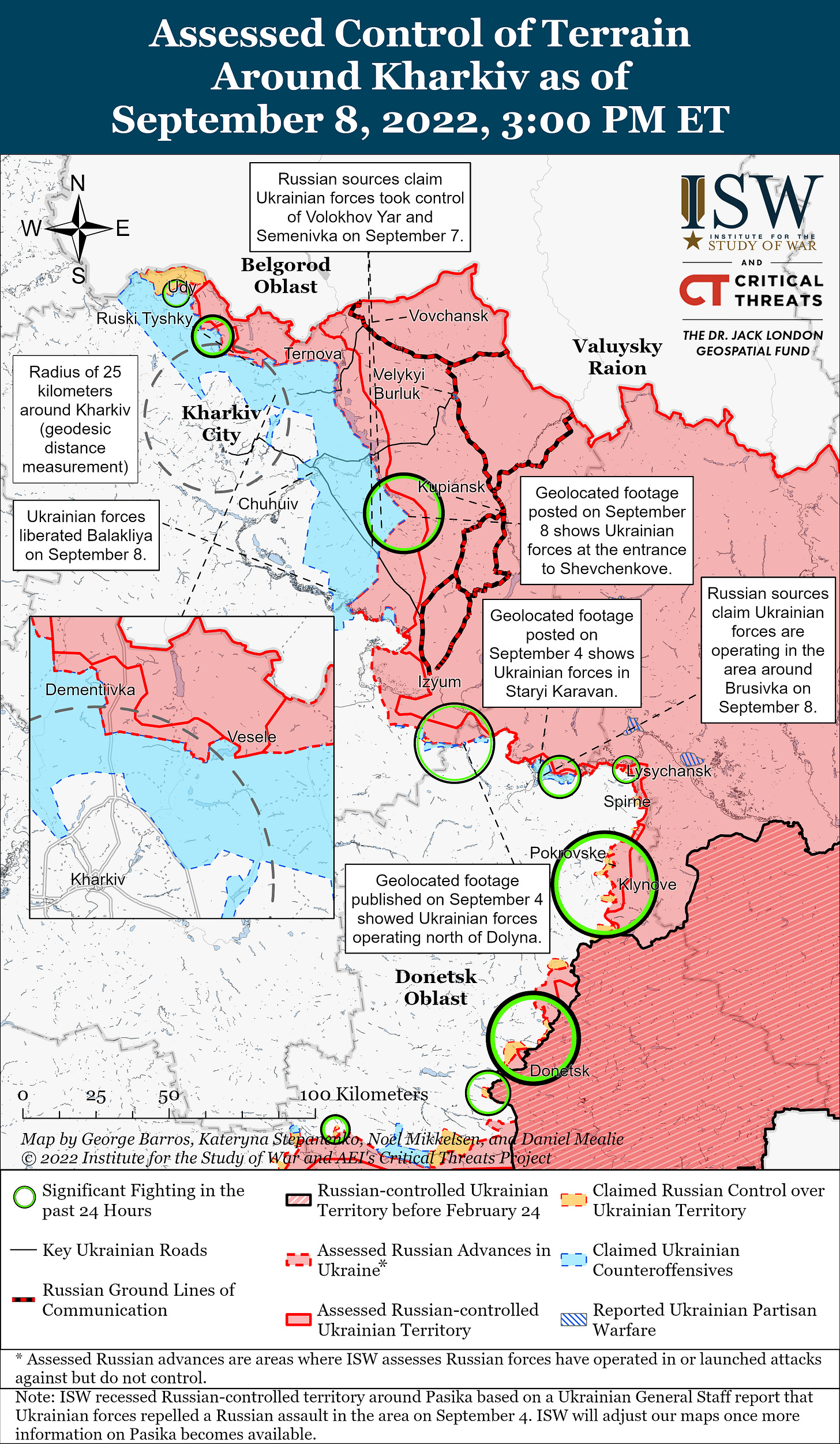With Rapid Offensive, Ukraine May Have Reached Turning Point In War

Ukrainian forces fire on Russian positions in Donetsk province
If you’re an officer at any level of command in a unit engaged in combat, it’s never a good sign when you get reports that your soldiers are taking off their uniforms and attempting to blend in with the civilian population. In military terms, that’s called desertion, and in this country it’s punishable by a significant stay at the Disciplinary Barracks in Fort Leavenworth, Kansas. I don’t know for sure, but if I were to guess, I’d think the punishment in Russia is a firing squad.
Several Russian units that have endured significant losses in areas east of Kharkiv have suffered desertions in that manner, the Ukrainian General Staff told reporters in Kyiv today. CNN quoted a military spokesman in Kyiv as saying, “Personnel of the occupying forces in civilian clothes resort to desertion and try to return to the territory of the Russian federation,” it added. “So, during the day, more than 15 such cases were noted.”
Just off the bat, if Ukrainian forces are close enough to Russian positions that they are able to detect these desertions, that would mean the Russian military is in what we used to call in the Army, a hurt-locker. “Geo-located social media videos confirm Ukrainian forces are fast advancing in the region,” CNN reported.
The Institute for the Study of War, a D.C.-based think tank that has had excellent reporting about the war since Russia launched its attack in late February, put it this way: “Ukrainian successes on the Kharkiv City—Izyum line are creating fissures within the Russian information space and eroding confidence in Russian command to a degree not seen since a failed Russian river crossing in mid-May.” What they’re talking about are the front lines in the combat taking place in the region south of Kharkiv where Ukraine has gained the most ground in the last few days.
The Wall Street Journal reported on Friday that Ukrainian forces had advanced at least 31 miles in the area south and east of Kharkiv, the largest Ukrainian city close to the Russian border and a key strategic position Ukraine has held since early in the war. The gains are Ukraine’s “biggest breakthrough in months of grinding combat.” Other reports are comparing the situation in the northeast of Ukraine to the moment during the war in April when Ukraine successfully drove Russian forces from positions they had occupied to the north and east of Kyiv. In colloquial military-ese, that’s big stuff.
The Ukrainian campaign in the east came as a surprise to Russia as well as war-watchers here, because Ukraine had spent about two weeks telegraphing its intentions to re-take Kherson in the south. Reports from the front lines in Ukraine are sketchy at the moment, but apparently that offensive is indeed under way, and Ukraine is achieving sporadic gains around Kherson, mainly using the HIMARS guided rocket system the U.S. recently shipped to Ukraine, as well as long-range artillery using 155 mm Howitzers, also supplied by the U.S.
But the Ukrainian offensive around Kherson does not appear to be a feint intended to distract Russia while Ukraine attacks elsewhere. Michael Kofman, the director of Russian studies at Center for a New American Security, a research institute just outside Washington, tweeted yesterday: “These appear to be interrelated offensives. Kherson likely intended as a more deliberate, sequenced advance. Kharkiv to take advantage of favorable conditions.”
Gen. Mark A. Milley, the chairman of the Joint Chiefs of Staff, told reporters at a news conference in Germany, “There is fighting — both offense and defense — all the way from Kharkiv all the way down to Kherson.”
The saber-rattling by Ukraine about Kherson and the gains they have made there forced Russia to move a number of its combat units south from the area east of Kharkiv, leaving that region vulnerable to attack by Ukraine, an offensive that is now fully underway according to multiple reports from the area.
Ukraine’s most significant offensive gains are in an area around the city of Kupyansk, a rail hub with a population of about 30,000 that has served as a key point in Russia’s resupply lines and a headquarters for Russian units in the northeast. The Institute for the Study of War predicted that Ukraine will likely take Kupyansk in 72 hours -- and in fact the Journal has since reported that Ukrainian forces took control of Kupyansk on Thursday night.
This was significant not only because as a rail-hub the city has served as the main point for Russian resupply in the northeast, but because it cut off Russian forces south toward Izyum, a larger city that Russia has used as a headquarters and staging area for its units in Ukraine’s east. According to the New York Times, Ukraine has driven the Russians out of Izyum.
This stuff is hard to follow and it takes referring from one map to another to pinpoint the towns and areas that reports from the front lines are talking about, but it appears that Ukrainian forces have retaken Balakiia, which was held by Russia and is just west of a strategic rail line between Kupyansk and Izyum. If Ukraine makes further advances east of Balakiia, which seems likely, it will cut off one of two major rail lines that run from Russia to Izyum, further endangering Russia’s hold on that key Ukrainian city. The map of the front lines in the northeast of Ukraine, supplied by the Institute for the Study of War, looks like this:

The small bulge into the area in red held by Russia just north of Izyum marks the Ukrainian front line east of Balakiia, close to one of the rail lines from Russia, depicted in black-and-red spotted lines. The Journal reported that, “A video purportedly filmed in Balakliia showed tearful women embracing Ukrainian soldiers on their doorstep and offering them pancakes.”
The Journal also reported that civilian occupation authorities installed by Russia announced yesterday that they were evacuating women and children in advance of what appeared to be Ukraine’s inevitable re-taking of Kupyansk. It was in that area that Russian soldiers were seen removing their uniforms and attempting to desert or “escape back to Russia,” as the Journal put it.
Given Russian losses across the entire front line in northeastern Ukraine, which have been heavy, but it seems to me that if the deserters make it back to the Russian border, it’s not likely they will be greeted with victory parades.
Secretary of Defense Lloyd Austin announced on Thursday that the U.S. will send another $675 million in military supplies to Ukraine, including 105 mm Howitzers, ammunition, Javelin anti-tank rockets, and air-launched missiles designed to knock out Russian radar installations. These things would be deployed by Ukrainian jet aircraft, so if you just go by the resupplies and what they’re intended for, it looks like Ukraine intends to keep up its campaigns in the northeast and the south and has aims to drive Russian forces completely out of the country.
Meanwhile, Russia just requested an emergency meeting of the Security Council of the United Nations to “discuss western arms supplies to Ukraine,” according to the Times. Russia has used previous Security Council meetings to accuse the U.S. and NATO of fomenting the war in Ukraine. That sounds suspiciously like the desperate bleating of a government that began a war that is not going well at all.
Lucian K. Truscott IV, a graduate of West Point, has had a 50-year career as a journalist, novelist, and screenwriter. He has covered Watergate, the Stonewall riots, and wars in Lebanon, Iraq, and Afghanistan. He is also the author of five bestselling novels. You can read his daily columns at luciantruscott.substack.com and follow him on Twitter @LucianKTruscott and on Facebook at Lucian K. Truscott IV.
Reprinted with permission from Lucian Truscott Newsletter
- Into the Breach: Ukraine's Counter-Offensive Begins - War on the ... ›
- Ukraine is losing fewer soldiers in its counter-offensive than Russia ... ›
- Kharkiv: As Ukraine pushes southern offensive, it also hits Russia in ... ›
- Kharkiv offensive: Russian forces retreat as Ukraine takes key towns ... ›
- Ukraine has telegraphed its big counteroffensive for months. So ... ›








